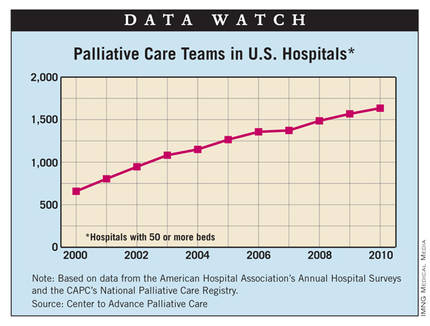
Palliative care, often confused with hospice care or palliative medicine, is a type of healthcare that provides support for patients and their families. This is for patients suffering from serious illnesses. It can help with pain and other symptoms. Palliative treatment can be provided anywhere. It can be offered at home, in skilled nursing facilities or in hospitals. It may be combined with curative treatment depending on the severity of your illness.
Psychosocial and spiritual support is provided to patients and their families by inter-disciplinary palliative care teams. These teams can include social workers, physicians, nurses, physiotherapists, occupational therapists, and physiotherapists. Family members and close friends may also be included.

Any age can be given to palliative medicine. You can initiate palliative care at any time, whether the patient is undergoing curative or end-of-life treatment. Symptom management is the main focus of palliative care, but the patient's family and friends also need to be included in the assessment. Palliative care may include medication, nutritional changes, or relaxation techniques. It is provided by a team comprised of health professionals.
Palliative care can be considered a natural extension to primary care. It involves coordination of care across all pathways, including primary, specialty, and tertiary. It includes a strong focus on quality and life. A palliative care team will assess a patient's medical condition, provide basic nursing care, and help manage symptoms and pain. The caregivers can also be trained to provide support to the patient with emotional support, subcutaneous injections for pain relief and physical support.
Palliative team members will listen to the patient’s concerns and needs, and also consider the family’s financial and emotional resources. The team may also review whether or not the patient has given advance medical directives and, if yes, whether those directives are being honored. They might also be interested in reviewing the patient's financial standing and conflicts among primary caregivers. They may also need to make a decision about when to stop caring for the patient.
A patient might need to be admitted for intensive intravenous liquid therapy. However, hospitalization may not be the best option. The fluids can be delivered directly under the skin, if the patient lives at home. This will allow the patient to maintain kidney function as well as overall comfort. In addition, a Carer Supports Needs Assessment Tool can be used to help the patient and family members identify their specific needs. The tool can also indicate that additional support is needed for the patient and family.

The most important aspect of palliative healthcare is the provision of emotional support. It is essential to determine the patient’s emotional needs at all stages of the illness, including the treatment and end. Without the patient and family's emotional support, the medical treatment may not be effective. It could cause pain and other symptoms that are already severe to get worse.
FAQ
What is the value of the health care system
A country's economy is only as strong as its health care system. It makes people live longer and more healthy lives. It creates jobs for nurses, doctors, and other medical professionals.
The health care system ensures that everyone can access quality healthcare services regardless of their income.
Understanding how the healthcare system works is crucial if you want to pursue a career in medicine, nursing, or any other medical profession.
What are the levels of health care facilities in each category?
The first level of care is the general practice clinics, which offer basic medical services for patients that do not require hospitalization. They can also refer patients to other providers, if necessary. This could include general practitioners and nurse practitioners as well as midwives.
The second level is primary care centers which offer comprehensive outpatient care, including emergency treatment. These include hospitals, walk in clinics, urgent care centres, family planning clinics and sexual health clinics.
The third level of care is secondary care centres, which offer specialty services such as eye surgery, orthopaedic surgery, and neurosurgery.
What do you need to know about insurance for health?
If you have health insurance, you should keep track of your policy documents. Make sure that you understand the plan and ask questions when you have doubts. Ask your provider questions or call customer support if you don't get it.
When it comes to using your insurance, make sure you take advantage of the deductible. Your deductible is the amount that you have to pay before your insurance covers the rest of the bill.
Statistics
- Over the first twenty-five years of this transformation, government contributions to healthcare expenditures have dropped from 36% to 15%, with the burden of managing this decrease falling largely on patients. (en.wikipedia.org)
- For the most part, that's true—over 80 percent of patients are over the age of 65. (rasmussen.edu)
- The healthcare sector is one of the largest and most complex in the U.S. economy, accounting for 18% of gross domestic product (GDP) in 2020.1 (investopedia.com)
- For instance, Chinese hospital charges tend toward 50% for drugs, another major percentage for equipment, and a small percentage for healthcare professional fees. (en.wikipedia.org)
- Consuming over 10 percent of [3] (en.wikipedia.org)
External Links
How To
What are the 4 Health Systems?
Healthcare systems are complex networks of institutions such as hospitals and clinics, pharmaceutical companies or insurance providers, government agencies and public health officials.
This infographic was created to help people understand the US healthcare system.
Here are some key points.
-
Annual healthcare spending amounts to $2 trillion, or 17% of GDP. That's almost twice the size of the entire defense budget!
-
Medical inflation reached 6.6% in 2015, which is more than any other consumer group.
-
Americans spend an average of 9% on their health costs.
-
As of 2014, there were over 300 million uninsured Americans.
-
Although the Affordable Health Care Act (ACA), has been approved by Congress, it hasn't yet been fully implemented. There are still gaps in coverage.
-
The majority of Americans think that the ACA needs to be improved.
-
The United States spends more on healthcare than any other country.
-
If every American had access to affordable healthcare, the total cost would decrease by $2.8 trillion annually.
-
Medicare, Medicaid, or private insurance cover 56%.
-
The top three reasons people aren't getting insured include not being financially able ($25 billion), having too much time to look for insurance ($16.4 trillion), and not knowing what it is ($14.7 billion).
-
There are two types: HMO (health maintenance organisation) and PPO [preferred provider organization].
-
Private insurance covers almost all services, including prescriptions and physical therapy.
-
The public programs cover outpatient surgery as well as hospitalizations, nursing homes, long term care, hospice, and preventive health care.
-
Medicare is a federal program which provides senior citizens with coverage for their health. It pays for hospital stays and skilled nursing facility stays.
-
Medicaid is a federal-state program that provides financial aid to low-income families and individuals who earn too little to be eligible for other benefits.